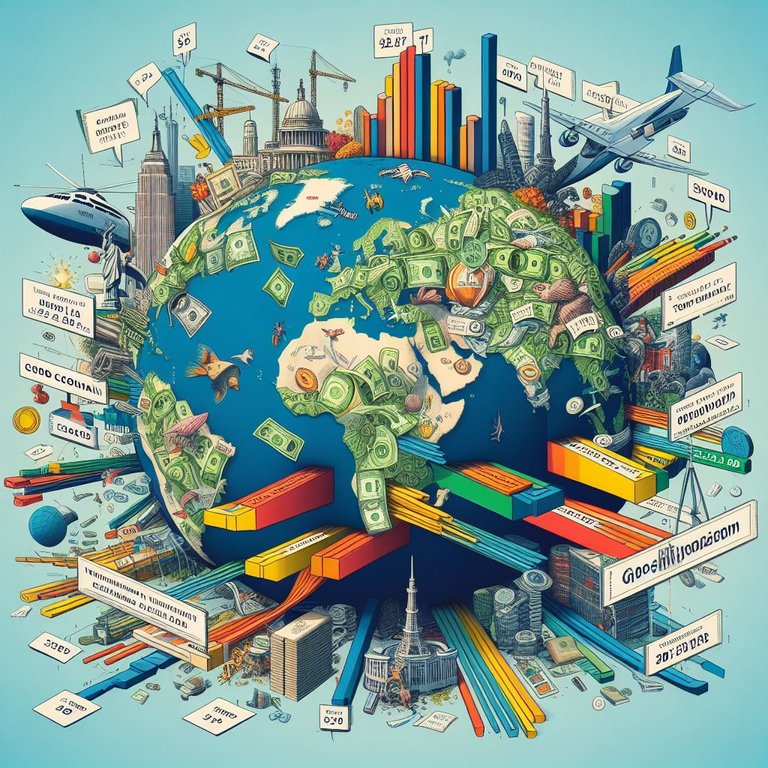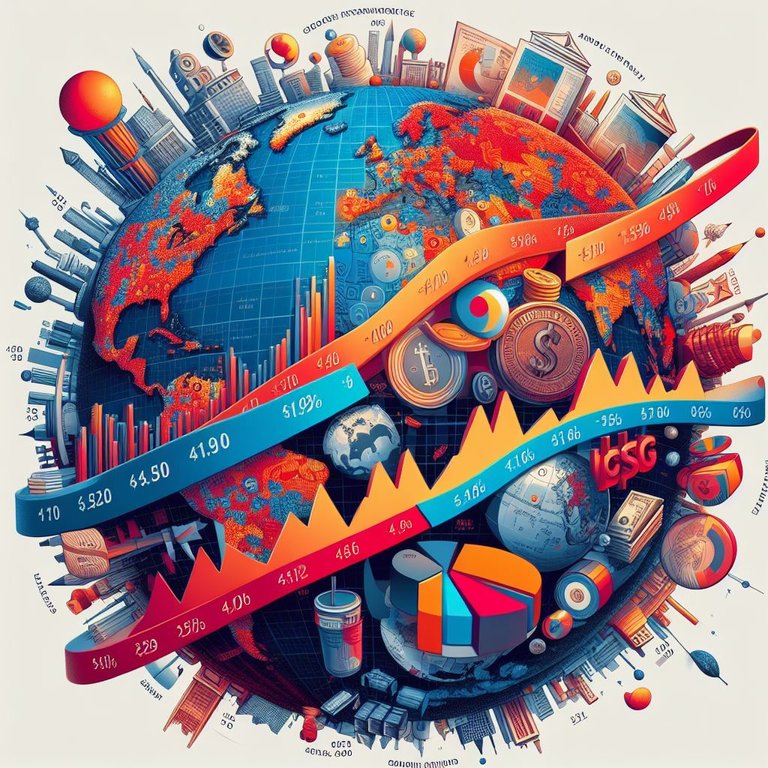The geopolitical divide will lead to losses for most participants in the global economic system, but the developing "neutral" economies will suffer more, IMF experts calculate: it will cause developing countries to fall further behind the developed ones.
Over the past decade, geopolitical contradictions have moved to the centre of attention of economists' attention, becoming one of the main factors determining the dynamics and prospects of the global economy and trade. The deepening geopolitical divide creates risks of the world economy disintegrating into competing blocs - risks of geo-economic fragmentation. Assessing the economic and social consequences of such risks has become a recurring theme in economic research in recent years. In a recent paper on this topic, IMF economists assessed how countries' existing geopolitical ties could affect their economies if the world were to divide into Eastern (China and its allies), Western (the US and its allies), and neutral blocs (countries that have no foreign policy agreements with either the US or China, or with both equally).
Developing and emerging countries in the neutral bloc would be hit harder: the loss of average real per capita income for the median developing country in Asia is 80 per cent higher, and in Africa 120 per cent higher, than for the median developed country. In other words, the greatest costs of fragmentation are borne precisely by those states that can least afford them, the authors conclude.

Estimates of the impact of global economic fragmentation
EBRD economists predict that global economic losses from the policy of friendsharing - creating supply chains with foreign policy allies - could reach 4.6 per cent of global GDP. The IMF calculates that losses from fragmentation of world trade could be as much as 7 per cent of global GDP, equivalent to the combined annual output of Germany and Japan. In another study, IMF economists together with experts from the Bank of Spain conclude that if the world economy splits into three blocs - western, eastern and neutral - the reduction in trade flows between the blocs will be up to 57%, depending on the severity of the scenario, and the blow will fall primarily on the eastern bloc, where the median country will lose up to 3.4% of wealth. According to another IMF study, all countries will suffer from rising commodity prices and their volatility in a polarised world economy. Experts from the ECB, the Bank of Canada, the Bank of Finland and the Dutch central bank also presented their estimates of losses.
Flows and alliances
Using Alliance Treaty Obligations and Provisions (ATOP) data on the geopolitical agreements signed by countries (military cooperation, neutrality, non-aggression), it is possible for any two countries to calculate an indicator of the coherence of their foreign policy. This indicator, constructed by the authors of the IMF study for 185 countries, varies between minus 1 and 1: the higher it is, the higher the geopolitical coherence of the two countries. For example, it is 0.85 for Germany and France, but only 0.21 for Germany and Angola. The median score for all country pairs was 0.54 and has been relatively constant over the past decade.
The authors compared the foreign policy coherence indicator with countries' trade flows across 10 product sectors for 2017-2019. It turns out that higher geopolitical coherence corresponds to lower trade barriers between countries. Trade in transport equipment, food and beverages, and goods classified in statistics as "other manufacturing" (which includes medical instruments and consumables, jewellery, and sporting goods, among others) is the most sensitive to it.
Even if countries are in economic or trade unions, the level of coherence of their foreign policies affects the "height" of their mutual trade barriers. This may be due to the presence of state restrictions (explicit or implicit) on trade with geopolitical adversaries in "sensitive" sectors, as well as lower levels of trust or higher uncertainty - additional barriers to firms trading across geopolitical divides.

A model of fragmentation
The authors calculated how trade barriers might change depending on several scenarios of geo-economic fragmentation.
The first is geopolitical polarisation, in which the current level of mutual geopolitical alignment between countries increases within the eastern and western geopolitical blocs and decreases between them. "Neutral" countries in this scenario do not change their foreign policy positions, but their relative alignment with other countries changes due to the increasing divergence between the two major blocs. Thus, the first scenario corresponds to an intensification of the already existing split along the East-West axis. The impact of geopolitics on trade does not change in this scenario and is consistent with the original calculations made on 2017-2019 data.
In contrast, the sensitivity of trade to geopolitical factors doubles in the second scenario. This variant is intended to capture how differences in foreign policy exchange rates trigger mechanisms (e.g. government restrictions or risk reassessment by firms) that transform geopolitical differences into higher trade barriers.
Finally, the third scenario combines the assumptions of the first two - and is seen by the authors as the baseline scenario, reflecting both the greater geopolitical divide and its growing impact on trade.
In the first scenario, the world's median economy faces a 0.2 per cent contraction in real income. About a quarter of the economies even show real income gains - this is because trade barriers are reduced for some country pairs (within blocs). The main beneficiaries of this development are Latin America and the Caribbean, which benefit from lower barriers with the US.
The second scenario leads to more significant losses for the median economy, as it implies a more significant increase in trade barriers: the real income of the median country falls already by about 1 per cent. The losses are somewhat smaller in developing Asia (about 0.7 per cent) and higher in the Middle East and Central Asia (1.5 per cent).
Finally, the third, baseline scenario leads to the highest losses for the median economy - 1.3 per cent of real income - as well as the most significant variation in outcomes across countries. Developed economies lose the least, at around 0.9 per cent. For developing countries, however, the effects are much more pronounced: the median country in developing Asia loses 80 per cent more, in sub-Saharan Africa 120 per cent more, and in the Middle East and Central Asia 150 per cent more than the median developed country. About a quarter of economies in the latter two groups of regions face real income declines of more than 3 per cent. In other words, the costs of geopolitical fragmentation fall disproportionately on the most vulnerable economies.

Headwinds
The impact of geopolitical fragmentation on a country is determined by three factors, the authors calculated:
- Market size: other things being equal, any increase in trade barriers leads to higher welfare losses for relatively small economies that tend to rely more on international trade;
- comparative advantage: economies that rely more on imports in sectors where trade barriers are highly sensitive to geopolitical alliances lose more from geo-economic fragmentation;
- pre-existing geopolitical alliances: countries with stronger geopolitical ties to the largest markets have less to lose from fragmentation than countries "equidistant" from the main centres of the world economy.
That is, smaller economies that are relatively loosely connected to major geopolitical blocs suffer the highest losses.
This situation, in turn, may lead to "neutral" countries trying to compensate for losses by concluding more agreements with each other or by joining one of the two competing blocs. The first option has the potential to slightly reduce the costs of geoeconomic fragmentation, but these changes are insufficient to alter the overall pattern of cost-sharing across countries and regions, economists calculated. The decision to join one of the "sides" is somewhat more effective, but it does not allow "neutral" countries to avoid significant welfare losses.
Developing countries and emerging markets may need to prepare for a decade when global trade trends turn from a tailwind for their economies into a headwind, the economists conclude.
The negative effects of fragmentation could be even more significant because, in addition to trade restrictions, fragmentation could limit migration, capital flows and international co-operation in general, IMF Managing Director Kristalina Georgieva noted. Developing countries in particular will feel it most strongly, as the spread of knowledge and technology that fuels their productivity and living standards will be hampered. And instead of catching up with developed economies, developing economies will fall further behind.
all images generated by bing / translated by an online translator